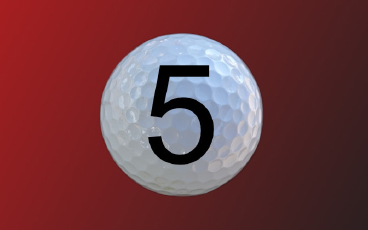1 – FLAWED THINKING
Being a full-time coach, I spend a lot of time on driving ranges.
I get to (am forced to) listen to all sorts of conversations from amateur golfers, which highlights one of the biggest reasons why they don’t improve – they are working on poor mechanics.
Imagine that – these golfers are trying to get better, but in the process are actively ruining their games. It’s similar to someone trying to lose weight by shoveling high-calorie foods down their mouth because they’ve been told that eating more increases our metabolic rate.
Much of the information is based on flawed thinking from 80’s instruction, but some of it is just the golfer’s own flawed hypotheses – usually based on some misunderstanding of correlation and causation.
For example, a golfer may hit a great shot, falsely attribute that good result to some feeling they had (which may have had nothing to do with the result), and then ingrain a flaw.
This is why a deeper education of how the swing works is needed – and this is something I educate players on in my online program, Next Level Golf.
2 – INGRAINING OF FAULTS
I’m an instructor who is careful of using the term “faults” – in theory, there are no incorrect ways to play golf, but there are certainly less effective/efficient ways to play.
Unfortunately, the vast majority of amateur golfers who practice without a coach are a bag of inefficient mechanics, all compensating for each other in some way. Let’s look at an example.
A golfer on the range is slicing the ball to the right due to a weak grip at set-up, causing an open face at impact.
If I gave 100 golfers this position, they would tend to hit more to the right
They hit balls for hours – after a while they figure out that they can straighten the ball flight out by adding a lot of wrist/forearm roll (supination) and early release to square the face.
While this does the job (it gets the face squarer at impact and the ball flies on target), it increases spin-loft so much that there is very little energy transferred into the ball. As a result of this energy-inefficiency, this player loses a lot of distance, and struggles with ground contact.
This player will eventually add other variables to their swing mechanics to improve ground contact – often inefficient variables which achieve the task, but at the expense of something else.
The chain-reaction continues until the player is an amalgamation of inefficiencies which “work” for the most part, but severely limit the player’s potential and may cause injury or inconsistency.
The above player (left) had found a way of getting the ball onto the target using a combination of a weak grip, left swing path and lots of early release. After (right), we managed to get the same directional results, but with an extra 50% in distance because the player had a more neutral path with less spin-loft (more forward shaft lean).
3 – CAN’T DO IT
Even in the unlikely event that a player is working on the right thing(s) for them (I can tell you from experience that most players are not), the majority of players struggle to do it.
Perhaps you have experienced this yourself, where you are working on a certain swing-move but you just can’t seem to do it with a ball there.
Making the swing we want seems effortless without the ball there. But, under the gun, the sight of that golf ball does strange things to us.
Now, this might be a physical issue, but (in most cases), if a player can perform the movement at full speed in a practice swing, there should be no reason why a player can’t perform it with that little white object there.
The fact is, most golfers don’t know how to learn effectively. They don’t understand how to change a motor program – they have no process or tools with which they can make swift and lasting movement-pattern shifts.
It’s one of the most frustrating things that an aspiring improving golfer experiences. It’s a huge roadblock which, once removed, opens up the floodgates to more rapid learning. There can be many reasons for it, including;
- Impact intentions which contradict the desired movement pattern
- Unrealistic expectations for performance in the initial stages
- Poor attentional control
- Desire to stay within comfort boundaries
The reality is, as long as you can do something in a practice swing, there is no reason why you can’t do it with a ball there – it’s just that your process for learning sucks.
This is why I devoted a whole module in Next Level Golf to improving your process, and finding solutions to the common roadblocks that amateurs experience in changing their movements.
4 – TRANSFER TO THE COURSE
Imagine this – we have our golfer who has managed to
- pick the right things to work on. They even have a
- Great learning process and are able to
- Make the change on the range.
Then they head to the course and it all goes haywire – they revert back to their old swing, or some hybrid between the old and new swings which is non-functional.
If you want to transfer your new movement to the course, you are going to have to
- Have exceptional attentional control
- Have spent more time ingraining the move with quality repetitions (not mindless ones)
- Have trained with games which simulate the course and game of golf better
Hitting 30 balls in a row from the same spot close to the flag might look fancy – but it’s not going to transfer well to the course, under pressure.
If all you have done is the usual scrape-hit-scrape-hit practice on the range, you will get what all other golfers get – an ability to perform well on the range, but a lack of on-course transference.
In Next Level golf, I have a library of awesome training games which greatly improve transference.
5 – THE BIGGEST ONE
The biggest reason golfers don’t improve is simple – what they are working on does not relate to improving impact.
As I stated in my (most popular ever) article – The Only Thing The Golf Ball Cares About – the ONLY WAY you can improve your shot quality is to improve impact or the consistency of impact.
Please bear in mind, I am not talking about the body positions here – I am talking about how the club-head interacts with the ball during that 0.75 inches of space where they are in contact.
What inputs are you giving to the ball during this 0.75 inch space?
Most golfers work on things in their swings which have absolutely no relevance to their specific impact patterns, and therefore never see any improvement. Usually, they have picked some random swing piece to work on based on what their favourite tour player does, or what the latest magazine article is promoting.
This is not a recipe for improvement.
ARE YOU READY TO IMPROVE?
If you have read all the way to the end, it’s likely you are a dedicated golfer with a passion for the game, and you really are genuine in your desire to improve.
I hope the article has given you some food for thought. As a quick re-cap;
- Educating yourself on proper swing mechanics, so you are working on the right things
- Setting up good cause-effect chains so that you don’t become a bag of compensating errors
- Improving your ability to do/learn those correct things
- Improving your ability to transfer this to the golf course, in playing/competitive conditions
- Making sure that what you change relates to your impact patterns/needs
Do all of the above and I can guarantee that your improvement will speed up.







